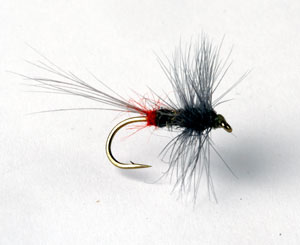As with most dry-fly fishing on rivers, everything should be scaled down a touch. Fish this pattern with a floating line, long leader and fine tippet.
Make a point of casting upstream and continually mend the line, so that drag doesn’t affect the pattern’s drift.
Just like other dry flies, it’s always best to cast to rising fish, but don’t be scared to try a little prospecting because it’s amazing just how many fish you’ll bring to the surface with dry-fly patterns – this one is no exception.
Hook: Standard dry size 14
Thread: Power silk or primrose 8/0
Tail and hackle: Blue dun cock
Body: Red rabbit fur and the grey underfur near the skin of a natural rabbit strip
How to tie the fly
 |
| 1. Run on a bed of tying thread. Create a small ball at the rear of the hook. This will make the tail fibres kick up when the tails are secured in tight against it. |
|
 |
| 2. Take several fibres, form a dun hackle and tie in on the top of the hook shank. Take the thread down to the ball area; this will kick the fibres up a touch. |
|
 |
| 3. Pinch some red rabbit fur from a patch and dub onto the thread – forming a very thin rope. Wind a couple of times around the hook shank in touching turns. |
|
 |
| 4. With the grey underfur, form another dubbing rope, again keeping it slim. |
|
 |
| 5. Wind the dubbing rope in tight touching turns up to the thorax area of the pattern. |
|
 |
| 6. Secure in a hackle by the stripped stalk at the back of the thorax area. |
|
 |
| 7. Create another dubbing rope and wind up, in touching turns, to a point behind the eye. |
|
 |
| 8. Wind the hackle up through the thorax area and secure with tying thread, then trim the waste end. |
|
 |
| 9. Now whip finish the fly and add a drop of varnish. |
|
Total Fly Fisher














